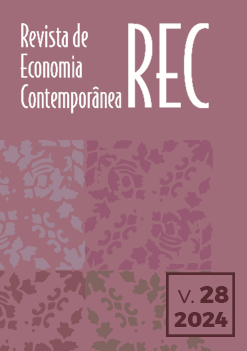Decomposition of GDP and the dynamics of Brazilian growth: an analysis based on different territorial disagregations
Keywords:
Economic growth. Productivity. Employment. Decomposition of GDP.Abstract
Aiming to recover the social-demographic relevance on economic growth, this research adapted Dunford’s approach and decomposed the growth of Brazilian GDP per capita in 2006-2019 (with different territorial disaggregation) into productivity (PROD), mobilization of human resources (MRHD), and potential workforce (FTP). Thus, the real (based on the decomposition itself) and potential impacts (via optimal scenarios) of each indicator on economic growth were evaluated, as were their degrees of regional correlation (via Moran’s I), convergence rates (according to Sala-I-Martin), and local determinants (by econometric-spatial estimates and additional control variables). Results indicate that, despite the decline in productivity, advances in MRHD (and less intensely in FTP) sustained economic growth. Although improvements in MRHD can generate high growth rates in relation to other components, this indicator obtained the highest regional correlation indices and the lowest convergence rates. Despite the usual focus given to productivity, the models focused on MRHD and FTP obtained greater explanatory power, suggesting that it would be possible to propose policies, with reasonable statistical confidence, that would encourage the more appropriate use of these indicators, with promising impacts on economic growth and reduction of regional inequalities.
Downloads
Downloads
Published
Issue
Section
License
Copyright (c) 2024 Hairiny Arruda Caires, Vinícius de Azevedo Couto Firme

This work is licensed under a Creative Commons Attribution 4.0 International License.


